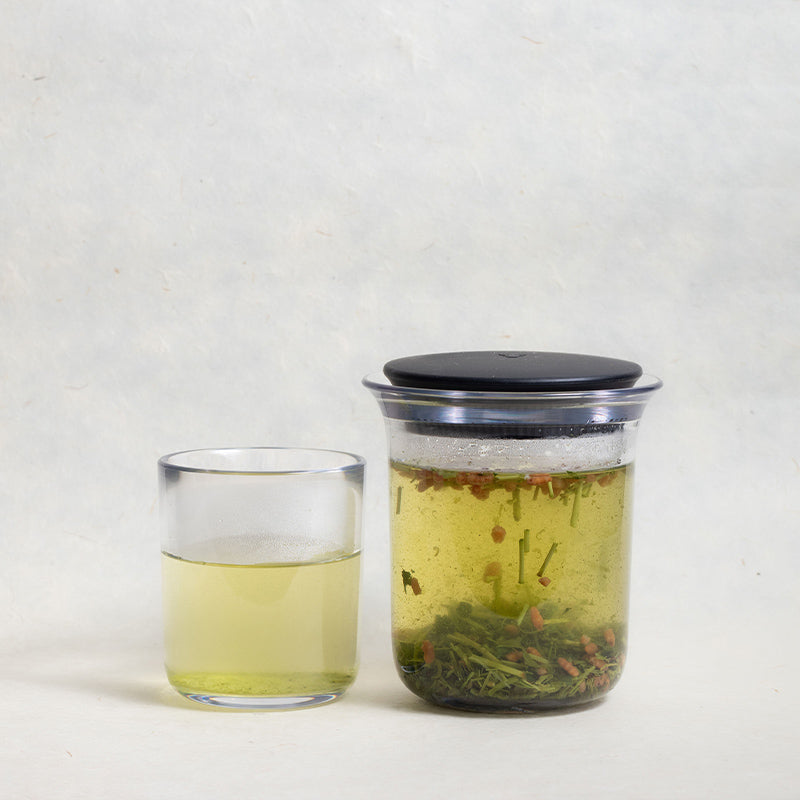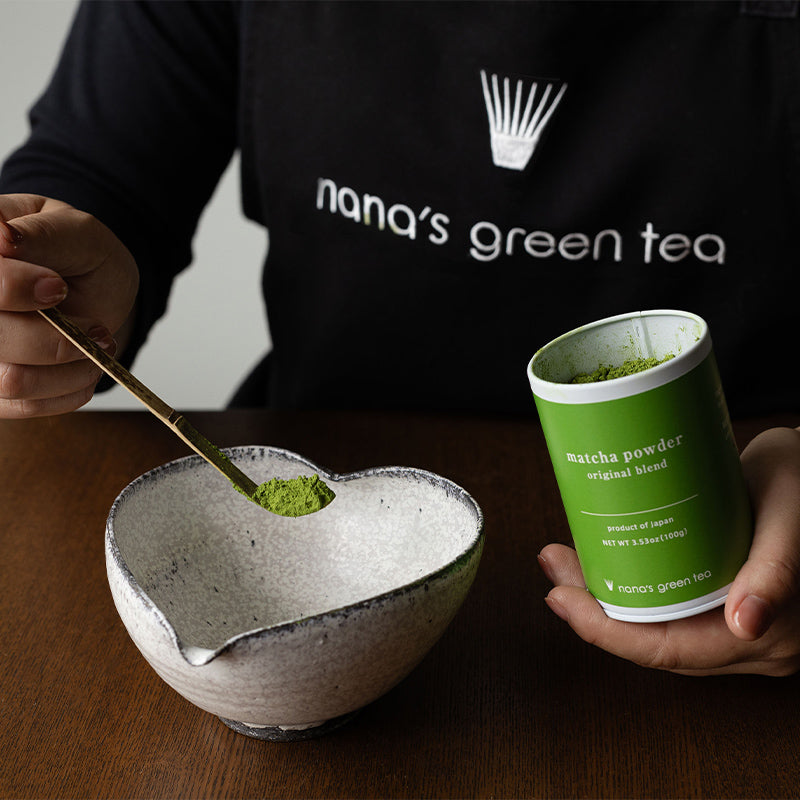Article: Explore Japanese Teas: Hojicha, Genmaicha, Sencha, and More
Explore Japanese Teas: Hojicha, Genmaicha, Sencha, and More
While matcha often takes center stage in conversations about Japanese tea, there is a wider world worth exploring. From the roasted warmth ofHojicha to the nutty depth of Genmaicha, Japanese green teas vary beautifully in taste, preparation, and purpose. Rooted in tradition and enjoyed in daily rituals, these teas each bring something special to the table.
In this guide, we explore several key Japanese teas, breaking down their history, how they are made, what they taste like, and when to enjoy them. You'll also find preparation tips, cultural insights, and recommendations for finding your ideal tea based on your lifestyle.

The Origins and History of Japanese Tea
Tea first arrived in Japan from China during the Nara period (710–794 CE), introduced by Buddhist monks who used it to stay alert during long meditations. At the time, tea was consumed primarily by the elite, with preparation methods evolving alongside Japan’s cultural shifts.
By the 12th century, the practice of drinking powdered tea gained popularity through the influence of Zen Buddhism. This laid the foundation for the Japanese tea ceremony, a meditative ritual that honors harmony, respect, purity, and tranquility.
As tea cultivation expanded throughout Japan, new styles emerged to suit everyday life. During the Edo period (1603–1868), Sencha, a steeped whole-leaf tea, became widely accessible, creating a new standard for daily tea drinking. Genmaicha, a blend of green tea and roasted rice, originated as a nourishing option for common households. Around this time, Hojicha was developed in Kyoto as a way to make use of leftover leaves, stems, and stalks by roasting them over high heat, a technique that created a warm, toasty tea with minimal bitterness and very low caffeine. Meanwhile, the historic region of Uji rose to prominence for producing some of the highest-quality teas in Japan, a reputation it holds to this day.
These teas reflect regional traditions and evolving preferences, shaped by centuries of cultivation and care. At Nana’s Green Tea, we honor these origins while presenting them in a modern, minimalistic way that invites you to savor each story. We’re proud to source our teas from Uji, bringing time-honored quality from the fields to your cup.
Understanding Japanese Green Teas
All Japanese green teas come from the Camellia sinensis plant, but their differences stem from how they are grown, harvested, and processed. While most are steamed to preserve their color and flavor, some are roasted, pan-fired, or blended with herbs or grains. Each technique affects caffeine levels, flavor profiles, and health benefits.
Tea Plant Parts & Processing Methods

Japanese teas can include different parts of the tea plant:
-
Leaves – Most premium teas like Sencha and Gyokuro are made primarily from the youngest tea leaves. These contain higher concentrations of amino acids and caffeine.
-
Stems and twigs – Used in teas like Kukicha and sometimes Hojicha, these parts are lower in caffeine and offer a mild, sweet flavor.
- Powdered leaves– Finely ground after steaming and drying, powdered tea leaves are used in teas like Matcha and Hojicha Powder. This format allows you to consume the entire leaf, resulting in a richer flavor and higher nutrient content.
After harvest, tea leaves are quickly steamed to halt oxidation. This is a key characteristic that distinguishes Japanese green teas from many Chinese varieties, which are typically pan-fired. Steaming preserves the leaves’ vibrant green color and enhances their naturally umami-rich profile.
From there, the processing methods vary by tea type. For teas like Sencha, the steamed leaves are carefully rolled and dried, helping to shape the leaf and influence how flavor is released during steeping. In the case of Genmaicha, the tea is later blended with roasted brown rice, adding a nutty, toasty aroma. Teas like Hojicha undergo an additional step: roasting over high heat. This technique lowers caffeine content and transforms the flavor into something warm, earthy, and comforting.
In powdered teas such as Matcha and Hojicha Powder, the leaves are stone-ground after drying. This allows the entire leaf to be consumed, intensifying both the flavor and the nutritional content of the tea.
Each of these methods brings out different characteristics of the same plant, resulting in a rich variety of teas that suit different moods, moments, and preferences.
Hojicha: The Roasted Green Tea

Overview
Hojicha is made by roasting green tea leaves at high temperatures, giving it a warm aroma and reddish-brown hue. Often made from Bancha or stem tea, it is naturally low in caffeine.
Flavor Profile
Toasty, earthy, and smoky. Low bitterness.
Preparation Tips
-
Water Temperature: 195–205°F (90–95°C)
-
Steeping Time: 30 seconds –1 minute (longer = deeper roast flavor)
Best Time to Enjoy
Evening, after meals, or as a relaxing wind-down drink.
Caffeine Level: Low
Shop:
Genmaicha: Green Tea with Roasted Rice

Overview
Genmaicha blends green tea with roasted brown rice. Originally a "people's tea," it’s now beloved for its mellow taste.
Flavor Profile
Savory, nutty, and toasty. The roasted rice adds warmth and a slight sweetness.
Preparation Tips
-
Water Temperature: 176–185°F (80–85°C) to avoid bitterness.
-
Steeping Time: 30 seconds–1 minute (oversteeping can make it astringent)
Best Time to Enjoy
Afternoon, with a meal, or as a grounding drink.
Caffeine Level: Low
Shop:
Sencha: Japan’s Everyday Green Tea

Overview
Sencha is the most widely consumed green tea in Japan. It’s grown in full sun and steamed after harvesting.
Flavor Profile
Fresh, grassy, and umami. Balanced with light sweetness.
Preparation Tips
-
Water Temperature: 158–176°F (70–80°C) Cooler = sweeter; hotter = more astringent
-
Steeping Time: 30 seconds–1 minute
-
Pro Tip: Use our 360 Kyusu Teapot for even extraction from any angle.
Best Time to Enjoy
Morning or early afternoon for a gentle energy boost.
Caffeine Level: Moderate
Shop:
Yuzu Green Tea: A Citrus Twist

Overview
Blended with dehydrated peel from a yuzu fruit, a fragrant, tart citrus fruit native to East Asia, this sencha green tea offers a vibrant citrus aroma and flavor. Yuzu Green is a popular cold-brew option during the summer in Japan.
Flavor Profile
Tart, umami, refreshing, and mildly sweet.
Preparation Tips
-
Hot: Water Temperature: 175°F (80°C) to avoid bitterness.
-
Steeping Time: 1–2 minutes
-
Cold-Brew: Steep 8-12 hours in the fridge for a smooth, sweet-tart flavor.
Best Time to Enjoy
Morning or early afternoon for a gentle energy boost.
Caffeine Level: Moderate
Shop:
Mint Green Tea: Cooling and Clean

Overview
Green tea blended with mint leaves. Ideal for warm weather or after a heavy meal.
Flavor Profile
Clean, umami, cooling, and subtly sweet.
Preparation Tips
-
Water Temperature: 175°F (80°C)
-
Steeping Time: 1–2 minutes (prevents mint from turning bitter)
Best Time to Enjoy
Morning or early afternoon for a gentle energy boost. After a meal to aid with digestion.
Caffeine Level: Moderate
Shop:
Common Brewing Mistakes
-
Oversteeping: This can lead to bitterness. Use a timer for best results.
-
Using boiling water: Most Japanese teas need lower temperatures. Use a thermometer or let boiled water cool.
-
Wrong water type: Use filtered water for the purest flavor.
-
Storing tea improperly: Light, heat, and air degrade freshness. Keep in airtight, opaque containers away from spices.
How to Choose the Right Japanese Tea for You
Not sure which to try? Consider your taste preferences, energy needs, and time of day:
-
Need a gentle pick-me-up? Try Sencha for a balanced caffeine boost.
-
Winding down in the evening? Hojicha is naturally low in caffeine and very calming.
-
Want something warming and savory? Genmaicha is perfect with meals or during cool weather.
-
Craving something bright or seasonal? Yuzu Green Tea or Mint Green Tea can lift your mood and palate.
Choosing a tea that suits your lifestyle can turn a simple drink into a ritual of comfort, clarity, or energy, depending on the moment. Here’s a quick guide based on need, taste preference, and caffeine level.
|
Need |
Try This Tea |
Why |
Caffeine / 8 oz Cup |
|
Winding down |
Roasted aroma, naturally calming |
Very low (trace to 10 mg) |
|
|
Midday reset |
Light, toasty, satisfying without overwhelming |
Low to moderate (10–30 mg) |
|
|
Feeling cold or sluggish |
Spicy warmth meets roasted depth |
Very low (trace to 10 mg) |
|
|
Focused mornings |
Brisk, grassy, with energizing umami |
Moderate (30–50 mg) |
|
|
A citrus lift |
Uplifting with bright citrus notes |
Moderate (30–50 mg) |
|
|
Cooling and refreshing |
Soothing mint meets grassy Sencha for a cool reset |
Moderate (30–50 mg) |

A Final Sip
Japanese green teas offer a full spectrum of flavor, aroma, and ritual. Whether you're drawn to the roasted richness of Hojicha, the savory comfort of Genmaicha, or the crisp brightness of Sencha Yuzu or Mint blends, there's a tea to complement every moment.
Each tea in Nana’s Green Tea collection reflects generations of tradition and expert care, thoughtfully curated to complement your modern lifestyle.




